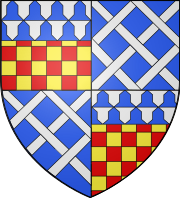
Back Marquess of Donegall German Marchese di Donegall Italian ドニゴール侯爵 Japanese Markiz Donegall Polish Маркиз Донегол Russian Маркіз Донегол Ukrainian
| Marquessate of Donegall | |
|---|---|
  Arms: Quarterly, 1st and 4th: Chequy Or and Gules, a Chief Vair (for Chichester); 2nd and 3rd: Azure fretty Argent (for Etchingham). Crest: A Stork proper, holding in the beak an Eel Argent. Supporters: On either side a Wolf Gules, ducally gorged and chained Or.[1] | |
| Creation date | 4 July 1791 |
| Created by | George III |
| Peerage | Peerage of Ireland |
| First holder | Arthur Chichester, 5th Earl of Donegall |
| Present holder | Patrick Chichester, 8th Marquess of Donegall |
| Heir apparent | James Chichester, Earl of Belfast |
| Remainder to | Heirs male of the body |
| Subsidiary titles | Earl of Donegall Earl of Belfast Viscount Chichester Baron Chichester Baron Fisherwick Baron Templemore |
| Status | Extant |
| Seat(s) | Dunbrody Park |
| Former seat(s) | Dunbrody House; Ormeau House; Belfast Castle; Donegall House |
| Motto | INVICTUM SEQUITUR HONOR (Honour follows him who does not seek it)[2] |
Marquess of Donegall is a title in the Peerage of Ireland held by the head of the Chichester family, originally from Devon, England. Sir John Chichester sat as a Member of Parliament and was High Sheriff of Devon in 1557. One of his sons, Sir Arthur Chichester, was Lord Deputy of Ireland from 1605 to 1616. In 1613, he was raised to the Peerage of Ireland as Baron Chichester, of Belfast in County Antrim. When he died childless in 1625 the barony became extinct.[3]
However, in the same year the Chichester title was revived in favour of his younger brother, Edward Chichester, who was made Baron Chichester, of Belfast in the County of Antrim, and Viscount Chichester, of Carrickfergus in County Antrim.[4] Both titles are in the Peerage of Ireland. He was succeeded by his eldest son, Arthur Chichester. A distinguished soldier, he was created Earl of Donegall in the Peerage of Ireland in 1647 (one year before he succeeded his father), with remainder to the heirs male of his father.[5][6]
He died without male issue and was succeeded (in the earldom according to the special remainder) by his nephew Arthur Chichester, the second Earl. He was the eldest son of Lieutenant-Colonel John Chichester, second son of the first Viscount. Lord Donegall had previously represented County Donegal in the Irish House of Commons. His eldest son, the third Earl, was a Major-General in the Spanish army and fought in the War of the Spanish Succession. He was killed in action in 1706. His eldest son, the fourth Earl, died childless and was succeeded by his nephew, the fifth Earl. He was the son of the Hon. John Chichester, younger son of the third Earl. Lord Donegall was created Baron Fisherwick, of Fisherwick in the County of Stafford, in the Peerage of Great Britain in 1790,[7] and one year later he was further honoured when he was made Earl of Belfast and Marquess of Donegall in the Peerage of Ireland.[8][9]
His grandson, the third Marquess, served as Captain of the Yeomen of the Guard under Lord John Russell between 1848 and 1852. In 1841, three years before he succeeded his father in the marquessate, he was created Baron Ennishowen and Carrickfergus, of Ennishowen in the County of Donegal and of Carrickfergus in the County of Antrim, in the Peerage of the United Kingdom.[10] Both his sons predeceased him and on his death in 1883 the barony of 1841 became extinct. He was succeeded in his other titles by his younger brother, the fourth Marquess. On the death of his grandson, the sixth Marquess, in 1975, the line of the second Marquess failed. The sixth Marquess was succeeded by his kinsman, the fifth Baron Templemore (see below), who became the seventh Marquess. From 1790 until 1999, when most hereditary seats were abolished with the passage of the House of Lords Act 1999, the Marquess sat in the House of Lords as Baron Fisherwick in the Peerage of Great Britain. As of 2015[update], the titles are held by the latter's son, the eighth Marquess, who succeeded in 2007.[2]
The county in Ulster from which the title is derived is now spelt Donegal. Several locations in Belfast are named after the family, such as Donegall Square, Donegall Place, Donegall Road, Donegall Pass, Donegall Quay, Chichester Street, Arthur Street, Arthur Square, and Chichester Park.
- ^ Burke, Bernard (1864). The General Armory of England, Scotland, Ireland, and Wales. London: Harrison & Sons. p. 192. Retrieved 22 December 2015.
- ^ a b "Obituaries: The Marquess of Donegall". The Daily Telegraph. 20 July 2007. Retrieved 22 December 2015.
- ^ "Arthur Chichester, Baron Chichester". Encyclopædia Britannica. Retrieved 22 December 2015.
- ^ Burke, Bernard (1914). Genealogical and Heraldic Dictionary of the Peerage and Baronetage of the British Empire. London: Burke's Peerage Limited. p. 636. Retrieved 22 December 2015.
- ^ Burke 1914, p. 636
- ^ Debrett, John (1822). The Peerage of the United Kingdom of Great Britain & Ireland: Volume 1. London: Debrett's. p. 905.
- ^ "No. 13210". The London Gazette. 19 June 1790. p. 373.
- ^ "No. 13322". The London Gazette. 5 July 1791. p. 387.
- ^ Debrett 1822, p. 906
- ^ "No. 20007". The London Gazette. 13 August 1841. p. 2072.
© MMXXIII Rich X Search. We shall prevail. All rights reserved. Rich X Search